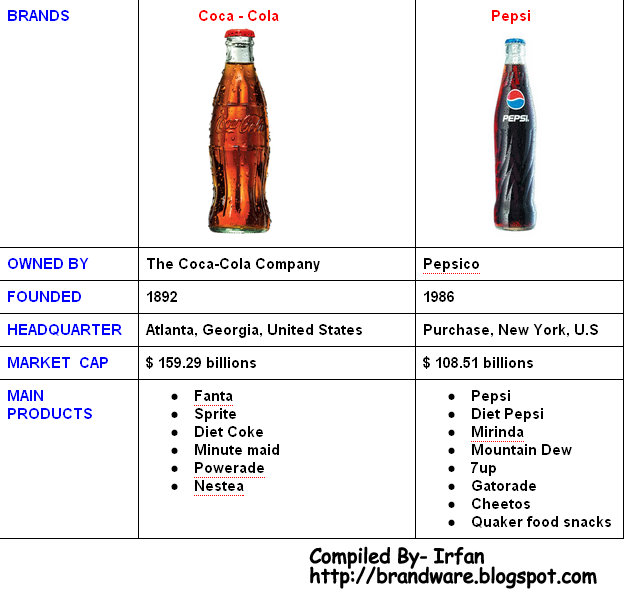The fight between these two major cola brands had hardly any impact on respective cola lovers as both the brands have strong brand following and it is due to this brand sincerity only that both the "Beverage giants" are unperturbed by the market share and constantly perform better. Here is the few data and number analysis of both brands.
ABOUT COCA-COLA
With a portfolio of more than 3,500 beverages, from diet and regular sparkling beverages to still beverages such as 100 percent fruit juices and fruit drinks, waters, sports and energy drinks, teas and coffees, and milk-and soy-based beverages, their variety spans the globe.
The coca-cola company offers a portfolio of more than 3,500 products in over 200 countries.
Market Cap: 159.03B
Brand Name: Coca-Cola
Drink Type: Soft Drink
Coca-Cola: Coca-Cola is the most popular and biggest-selling soft drink in history, as well as the best-known product in the world.
On May 8, 2011, Coca-Cola marks its 125th anniversary. Created in 1886 in Atlanta, Georgia, by Dr. John S. Pemberton, Coca-Cola was first offered as a fountain beverage at Jacob's Pharmacy by mixing Coca-Cola syrup with carbonated water.
Coca-Cola was patented in 1887, registered as a trademark in 1893 and by 1895 it was being sold in every state and territory in the United States. In 1899, The Coca-Cola Company began franchised bottling operations in the United States.
Coca-Cola might owe its origins to the United States, but its popularity has made it truly universal. Today, we can find Coca-Cola in virtually every part of the world.
Available in the following flavor: Cola.
Available in the following locations: Afghanistan, Albania, Algeria, American Samoa, Angola, Antigua & Barbuda, Argentina, Armenia, Aruba, Australia, Austria, Azerbaijan, Bahamas, Bahrain, Bangladesh, Barbados, Belarus, Belgium, Belize, Benin, Bermuda, Bolivia, Bosnia & Herzegovina, Botswana, Brazil, British Virgin Islands, Bulgaria, Burkina Faso, Burundi, Cambodia, Cameroon, Canada, Cape Verde, Cayman Islands, Central African Republic, Chad, Chile, China, Colombia, Comoros, Costa Rica, Croatia, Curacao, Cyprus, Czech Republic, Democratic Republic of Congo, Denmark, Djibouti, Dominica, Dominican Republic, Ecuador, Egypt, El Salvador, Equatorial Guinea, Eritrea, Estonia, Ethiopia, Fiji, Finland, France, French Guiana, French Polynesia, Gabon, Georgia, Germany, Ghana, Great Britain, Greece, Grenada, Guadeloupe, Guam, Guatemala, Guinea, Guinea-Bissau, Guyana, Haiti, Honduras, Hong Kong, Hungary, Iceland, India, Indonesia, Israel, Italy, Ivory Coast, Jamaica, Japan, Jordan, Kazakhstan, Kenya, Kuwait, Kyrgyzstan, Latvia, Lebanon, Lesotho, Liberia, Lithuania, Luxembourg, Macau (Macao), Macedonia, Madagascar, Malawi, Malaysia, Maldives, Mali, Malta, Mariana Islands, Martinique, Mauritania, Mauritius, Mayotte, Mexico, Moldova, Mongolia, Montserrat, Morocco, Mozambique, Namibia, Nauru, Nepal, Netherlands, New Caledonia, New Zealand, Nicaragua, Niger, Nigeria, Northern Ireland, Norway, Oman, Pakistan, Panama, Papua New Guinea, Paraguay, Peru, Philippines, Poland, Portugal, Puerto Rico, Qatar, Republic of Congo, Republic of Ireland, Republic of Korea, Reunion, Romania, Russia, Rwanda, Saint Helena, Saint Kitts and Nevis, Saint Lucia, Saint Maarteen, Saint Vincent & the Grenadines, Samoa, Sao Tome & Principe, Saudi Arabia, Senegal, Serbia & Montenegro, Seychelles, Sierra Leone, Singapore, Slovakia, Slovenia, Solomon Islands, South Africa, Spain, Sri Lanka, Suriname, Swaziland, Sweden, Switzerland, Taiwan, Tanzania, Thailand, The Gambia, Togo, Tonga, Trinidad & Tobago, Tunisia, Turkey, Turkmenistan, Turks & Caicos Islands, U.S. Virgin Islands, Uganda, Ukraine, United Arab Emirates, United States, Uruguay, Uzbekistan, Vanuatu, Venezuela, Vietnam, West Bank-Gaza, Yemen, Zambia and Zimbabwe.
Here is the brief comparison between the two-
ABOUT PEPSI
BEGINNING : Caleb Bradham knew that to keep people returning to his pharmacy, he would have to turn it into a gathering place. Like many pharmacists at the turn of the century, he had a soda fountain in his drugstore, where he served his customers refreshing drinks that he created himself. His most popular creation was a unique mixture of carbonated water, kola nuts, vanilla and rare oils, named “Brad’s Drink” by his customers. Caleb decided to rename it “Pepsi-Cola,” and advertised his new soft drink to enthusiastic customers. Sales of Pepsi-Cola started to grow, convincing him to form a company and market the new beverage. In 1902, he launched the Pepsi-Cola Company in the back room of his pharmacy, and applied to the U.S. Patent Office for a trademark. An official patent was awarded on June 16, 1903. At first, he mixed the syrup himself and sold it exclusively through soda fountains. But soon Caleb recognized that a greater opportunity existed—to bottle Pepsi-Cola so that people everywhere could enjoy it.
Advertising Pepsi-Cola as “Exhilarating,
Invigorating, Aids Digestion,” the business
began to grow. Caleb sold 7,968 gallons of
syrup in 1903. Two years later, he
awarded two franchises to bottle PepsiCola
to independent investors in Charlotte
and Durham, North Carolina. In 1906, the
number of franchises grew to 15, and
leapt to 40 by 1907. By the end of 1910,
there were Pepsi-Cola franchises in 24
states, and the company was selling more
than 100,000 gallons of syrup per year.
Building a strong franchise system was
one of Caleb’s greatest achievements.
Local Pepsi-Cola bottlers, entrepreneurial
in spirit and dedicated to the product’s
success, provided a sturdy foundation for
a growing company. They were then, and
continue to be today, the cornerstone of
the Pepsi-Cola enterprise.
Here is the graphical comparison of the two brands on (YOY) basis at NYSE.
KO- (The Coca-Cola Company)
PEP- (Pepsico) Graph courtesy- Yahoo finance ltd.





